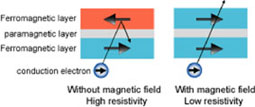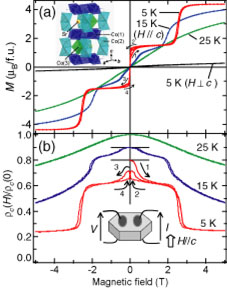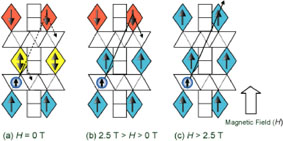Dr ISHIWATA, S., Assistant Professor SAITO, T., Professor Emeritus TAKANO, M. and their research group, “Observation of Multi-Staged Magnetoresistance in Novel Cobalt Oxides” (25 May 07)
|
Dr ISHIWATA, S., Assistant Professor SAITO, T., Professor Emeritus TAKANO, M.
Published in Physical Review Letters, 25 May 2007. |
||
| Researchers at the Institute for Chemical Research and collaborators at Waseda Univ., JST-ERATO, University of Tokyo, and Osaka University have discovered a giant multi-staged magnetoresistance with a uniaxial anisotropy in a novel cobalt oxide SrCo6O11. |  Dr ISHIWATA, S(left); Dr SAITO, T(center); Dr TAKANO, M(right) |
|
| Ferromagnetic metals show a negative magnetoresistance effect because of the spin-dependent band structure. Although this effect is typically small, the discovery of giant magnetoresistance (GMR) in multilayer thin films as illustrated in Fig. 1 has spurred intensive studies on novel spin-electronic devices. | ||
 Fig. 1 Schematic illustration of giant magnetoresistance in a multilayer thin film. |
The GMR effect has been applied in hard disk drives as a GMR head. On the other hand, bulk materials such as perovskite manganese oxides have been found to show GMR effects also, which is putting forward new physics such as the electronic phase separation arising from competitive orders. To be noted here is that both kinds of systems are similar in the sense that the GMR effects are induced by a transition between two states, i.e., an antiferromagnetic state with a high resistivity and a ferromagnetic state with a low resistivity. | |
| Now, Ishiwata et al. have discovered a novel type of GMR effect in a newly found cobalt oxide SrCo6O11, that is, a giant multi-staged magnetoresistance in a magnetic field applied along a specific direction (Fig. 2). The single crystals of SrCo6O11 have been synthesized under a high pressure of 2 GPa. While the GMR effect in multilayer thin films is operated by switching the magnetization direction of magnetic domains, that of SrCo6O11 is field-induced sequential phase transitions, which is an essentially different phenomenon. The most important feature of this material is that localized spins showing unusual behavior couple strongly with spin-polarized conduction electrons. As shown in Fig. 3, when an external magnetic field is applied parallel to the specific direction (c axis), sequential magnetic phase transitions occur, giving rise to the multi-staged magnetoresistance. In SrCo6O11, interesting characteristics of localized spins such as the strong uniaxial anisotropy and the competitive nature of magnetic orders reflect directly on the electronic conduction. Therefore, SrCo6O11 can be regarded as a novel magnetoresistive material in which localized spins are finely tuned at an atomic scale. | ||
 Fig. 2 (a)1/3 plateau in magnetization and (b)two-staged magnetoresistance with a uniaxial anisotropy in SrCo6O11. |
 Fig. 3 Schematic illustration of two-staged magnetoresistancein SrCo6O11. |
|
| This work was published in Physical Review Letters, 25th May 2007 (Phys. Rev. Lett. 98, 217201 (2007)). | ||
 Institute for Chemical Research, Kyoto University
Institute for Chemical Research, Kyoto University International Joint Usage Research Center
International Joint Usage Research Center